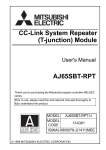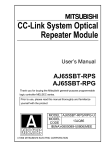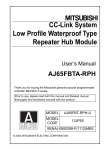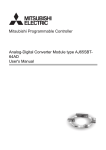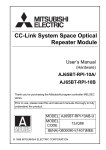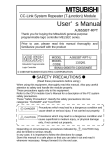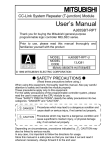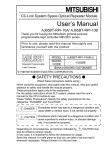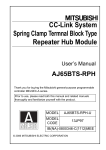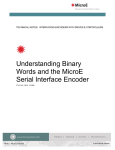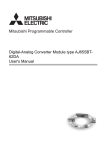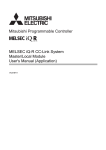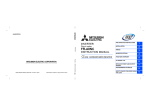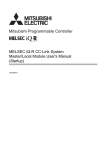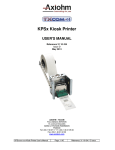Download CC-Link System Optical Repeater Module User`s Manual
Transcript
CC-Link System Optical
Repeater Module
User’s Manual
AJ65SBT-RPS
AJ65SBT-RPG
Thank you for buying the Mitsubishi general-purpose programmable
controller MELSEC-A series.
Prior to use, please read this manual thoroughly and familiarize
yourself with the product
MODEL AJ65SBT-RPS/RPG-U
MODEL
13JQ85
CODE
IB(NA)-0800089-M(1411)MEE
© 1999 MITSUBISHI ELECTRIC CORPORATION
SAFETY PRECAUTIONS
(Read these precautions before using this product.)
Before using this product, please read this manual and the relevant manuals
carefully and pay full attention to safety to handle the product correctly.
In this manual, the safety precautions are classified into two levels:
"
WARNING" and "
CAUTION".
WARNING
Indicates that incorrect handling may cause
hazardous conditions, resulting in death or severe
injury.
CAUTION
Indicates that incorrect handling may cause
hazardous conditions, resulting in minor or moderate
injury or property damage.
Under some circumstances, failure to observe the precautions given under
"
CAUTION" may lead to serious consequences.
Observe the precautions of both levels because they are important for personal
and system safety.
Make sure that the end users read this manual and then keep the manual in a safe
place for future reference.
1
[Design Precautions]
WARNING
● Input/output could be switched on or off when a problem occurs in the
repeater module.
So build an external monitoring circuit that will monitor any input/output
signals that could cause a serious accident.
CAUTION
● Use the programmable controller in the environment that meets the general
specifications contained in this Manual.
Using the programmable controller outside the range of the general
specifications may result in electric shock, fire or malfunction, or may damage
or degrade the module.
● Do not have control cables and communication cables bundled with or placed
near by the main circuit and/or power cables. It may cause malfunction due to
noise interference. Wire those cables at least 100mm(3.94 inch) away from
the main circuit and/or power cables.
[Installation Precautions]
CAUTION
● Do not directly touch the module's conductive parts or electronic components.
Doing so may cause malfunctions or failure of the module.
● Tighten the module securely using DIN rail or installation screws within the
specified torque range.
Loose terminal screws may cause falling, short circuit or erroneous operation.
If the terminal screws are too tight, it may cause falling or short circuit due to
damage of the screws.
2
[Wiring Precautions]
WARNING
● Be sure to shut off all phases of the external power supply used by the system
before installation or wiring. If the power is not disconnected at all phases an
electric shock or product damage may result.
CAUTION
● Ground the FG terminal to the protective ground conductor dedicated to the
programmable controller. Failure to do so will result in electric shock or
malfunction.
● Be sure to tighten any unused terminal screws within a tightening torque
range (0.42 to 0.50N•m). Failure to do so may cause a short circuit due to
contact with a solderless terminal.
● Use applicable solderless terminals and tighten them with the specified
torque. If any solderless spade terminal is used, it may be disconnected when
the terminal screw comes loose, resulting in failure.
● Perform correct wiring for the module according to the product's rated voltage
and terminal arrangement. Connecting to a power supply different from the
rating or mis-wiring may cause fire and/or trouble.
● Fix terminal screws securely with the specified torque.
Loose terminal screws may cause short circuit or malfunction.
If the terminal screws are too tight, it may cause falling, short circuit or
erroneous operation due to damage of the screws or module.
● Make sure foreign objects do not get inside the module, such as dirt and wire
chips.
It may cause fire, trouble or malfunction.
● Be sure to fix the cables that are connected to the module in place, either by
running them through a duct or by using clamps.
If the cables are not fixed in one of these ways, dispersion, movement, or
careless pulling of the cables may cause damage to the module or cables, or
malfunction due to cable contact faults.
3
[Wiring Precautions]
CAUTION
● When removing the cable from the module, do not pull the cable. When
removing the cable with a connector, hold the connector on the side that is
connected to the module.
When removing the cable connected to the terminal block, first loosen the
screws on the part that is connected to the terminal block.
Pulling the cable that is still connected to the module may cause malfunction
or damage to the module or cable.
[Startup and Maintenance Precautions]
WARNING
● Do not touch terminals when the power is on.
It may cause an electric shock or malfunction.
CAUTION
● Never try to disassemble or modify module.
It may cause trouble, malfunction, injury or fire.
● Do not drop or apply any strong impact to the module.
Doing so may damage the module.
● Be sure to shut off all phases of the external power supply used by the system
before cleaning or retightening the terminal screws. If you do not switch off the
external power supply, it will cause trouble or malfunction of the module.
● Be sure to fix the wires or cables by ducts or clamps when connecting them to
the module.
Failure to do so may cause damage of the module or the cables due to
accidental pull or unintentional shifting of the cables, or malfunctions due to
poor contact of the cable.
● Do not install the control lines together with the communication cables, or
bring them close to each other.
Failure to do so may cause malfunctions due to noise.
● Do not install/remove the terminal block more than 50 times after the first use
of the product. (IEC 61131-2 compliant)
● Before handling the module, always touch grounded metal, etc. to discharge
static electricity from the human body.
Failure to do so can cause the module to fail or malfunction.
4
[Disposal Precautions]
CAUTION
● When disposing of this product, treat it as industrial waste.
5
CONDITIONS OF USE FOR THE PRODUCT
(1) Mitsubishi programmable controller ("the PRODUCT") shall be used in
conditions;
i) where any problem, fault or failure occurring in the PRODUCT, if any,
shall not lead to any major or serious accident; and
ii) where the backup and fail-safe function are systematically or
automatically provided outside of the PRODUCT for the case of any
problem, fault or failure occurring in the PRODUCT.
(2) The PRODUCT has been designed and manufactured for the purpose of
being used in general industries.
MITSUBISHI SHALL HAVE NO RESPONSIBILITY OR LIABILITY
(INCLUDING, BUT NOT LIMITED TO ANY AND ALL RESPONSIBILITY
OR LIABILITY BASED ON CONTRACT, WARRANTY, TORT, PRODUCT
LIABILITY) FOR ANY INJURY OR DEATH TO PERSONS OR LOSS OR
DAMAGE TO PROPERTY CAUSED BY the PRODUCT THAT ARE
OPERATED OR USED IN APPLICATION NOT INTENDED OR
EXCLUDED BY INSTRUCTIONS, PRECAUTIONS, OR WARNING
CONTAINED IN MITSUBISHI'S USER, INSTRUCTION AND/OR SAFETY
MANUALS, TECHNICAL BULLETINS AND GUIDELINES FOR the
PRODUCT.
("Prohibited Application")
Prohibited Applications include, but not limited to, the use of the PRODUCT
in;
• Nuclear Power Plants and any other power plants operated by Power
companies, and/or any other cases in which the public could be
affected if any problem or fault occurs in the PRODUCT.
• Railway companies or Public service purposes, and/or any other cases
in which establishment of a special quality assurance system is
required by the Purchaser or End User.
• Aircraft or Aerospace, Medical applications, Train equipment, transport
equipment such as Elevator and Escalator, Incineration and Fuel
devices, Vehicles, Manned transportation, Equipment for Recreation
and Amusement, and Safety devices, handling of Nuclear or
Hazardous Materials or Chemicals, Mining and Drilling, and/or other
applications where there is a significant risk of injury to the public or
property.
6
Notwithstanding the above, restrictions Mitsubishi may in its sole discretion,
authorize use of the PRODUCT in one or more of the Prohibited
Applications, provided that the usage of the PRODUCT is limited only for
the specific applications agreed to by Mitsubishi and provided further that
no special quality assurance or fail-safe, redundant or other safety features
which exceed the general specifications of the PRODUCTs are required.
For details, please contact the Mitsubishi representative in your region.
7
REVISIONS
* The manual number is given on the bottom right of the top cover.
Print Date
* Manual Number
Nov., 1999
IB (NA)-0800089-A
Jun., 2000
IB (NA)-0800089-B
Revision
First edition
Correction
Section 2.2(5)
Jan., 2001
IB (NA)-0800089-C
Correction
Section 3.3.2(3)
Mar., 2005
IB (NA)-0800089-D
Addition
Conformation to the EMC Directive and Low
Voltage Instruction
Correction
SAFETY PRECAUTIONS, About the Manuals,
Abbreviated names, generic names and terms,
Chapter 1, Section 1.1, 2.1, 2.3, 3.1, 3.2, 3.3.1,
3.3.2, 3.4, 4.1, 4.2.1, 4.2.2, 4.3, 4.4, 4.7, 4.8,
Chapter 5, Chapter 6
Mar., 2006
IB (NA)-0800089-E
Correction
REVISIONS, Conformation to the EMC Directive
and Low Voltage Instruction, Section 2.2, 2.3
Sep., 2006
IB (NA)-0800089-F
Correction
SAFETY PRECAUTIONS
Dec., 2006
IB (NA)-0800089-G
Correction
About the Manuals, Abbreviated names, generic
name and terms, Section 2.3, 3.2, 3.3.1, 4.2.1
Jul., 2007
IB (NA)-0800089-H
Correction
Section 4.3, Chapter 6
Jun., 2008
IB (NA)-0800089-I
Correction
Compliance with the EMC Directive and the Low
Voltage Directive, Chapter 1, Section 2.3, Section
3.2, 3.3.1, 3.4
Sep., 2009
IB (NA)-0800089-J
Correction
SAFETY PRECAUTIONS , Section 2.3, 3.1, 3.2,
3.3.2, 4.2.1
8
* The manual number is given on the bottom right of the top cover.
Print Date
* Manual Number
Dec., 2011
IB (NA)-0800089-K
Revision
Addition
SAFETY PRECAUTIONS(Chinese),
CONDITIONS OF USE FOR THE PRODUCT
Correction
SAFETY PRECAUTIONS, About the Manuals,
COMPLIANCE WITH EMC AND LOW VOLTAGE
DIRECTIVES, Section 3.1, 4.2.1, 4.7
Apr., 2012
IB (NA)-0800089-L
Correction
Section 3.2
Nov., 2014
IB (NA)-0800089-M
Addition
Section 2.3
Correction
Related Manual, ABBREVIATED NAMES,
GENERIC NAMES AND TERMS, Section 2.4, 3.2,
3.3.1, 4.3, Chapter 6,
Change
from Section 2.3 to Section 2.4
This manual confers no industrial property rights or any rights of any other kind,
nor dose it confer any patent licenses. Mitsubishi Electric Corporation cannot be
held responsible for any problems involving industrial property rights which may
occur as a result of using the contents noted in this manual.
© 1999 MITSUBISHI ELECTRIC CORPORATION
9
CONTENTS
1. OVERVIEW .................................................................................................. 15
1.1
Features .............................................................................................. 15
2. SYSTEM CONFIGURATION........................................................................ 17
2.1
Total configuration............................................................................... 17
2.2
Checking hardware versions............................................................... 18
2.3
Checking serial number ...................................................................... 18
2.4
Cautions on system configuration ....................................................... 19
3. SPECIFICATIONS........................................................................................ 27
3.1
General specifications......................................................................... 27
3.2
Performance specifications ................................................................. 29
3.3 Specifications of connection cables .................................................... 31
3.3.1
CC-Link dedicated cable ........................................................... 31
3.3.2
Optical fiber cable specifications ............................................... 31
3.4 Max. transmission distance................................................................. 33
4. PROCEDURE UP TO START OF DATA LINK ........................................... 34
4.1
Procedure up to start of data link ........................................................ 34
4.2 Mounting and installation .................................................................... 35
4.2.1
Cautions on handling ................................................................. 35
4.2.2
Installation environment............................................................. 36
4.3 Names and settings of parts ............................................................... 37
4.4
Check of module state (Hardware test)............................................... 40
4.5
Setting of switches .............................................................................. 41
4.6
Installation and removal of protective cover........................................ 42
4.7
Connection of module through cable .................................................. 43
4.8
Check for state of connection (Line test)............................................. 44
5. TROUBLESHOOTING ................................................................................. 46
6. EXTERNAL DIMENSIONS........................................................................... 51
10
ABOUT THE MANUALS
The following manuals are related to this product.
Referring to this list, please request the necessary manuals.
Related Manual
Manual name
Manual Number
(Model code)
MELSEC iQ-R CC-Link System Master/Local Module User's Manual
(Startup)
SH-081269ENG
13JX10
MELSEC iQ-R CC-Link System Master/Local Module User's Manual
(Application)
SH-081270ENG
13JX19
MELSEC-Q CC-Link System Master/Local Module User's Manual
SH-080394E
(13JR64)
MELSEC-L CC-Link System Master/Local Module User's Manual
SH-080895ENG
13JZ41
CC-Link System Master/Local Module Type
AJ61QBT11/A1SJ61QBT11 User's Manual
IB-66722
(13J873)
CC-Link System Master/Local Module Type AJ61BT11/A1SJ61BT11
User's Manual
IB-66721
(13J872)
CC-Link System Repeater (T-junction) Module User's Manual
AJ65SBT-RPT
IB-0800078
(13JQ81)
CC-Link System Space Optical Repeater Module User's Manual
AJ65BT-RPI-10A/AJ65BT-RPI-10B
IB-0800090
(13JQ86)
CC-Link System Low Profile Waterproof Type Repeater Hub Module
User's Manual AJ65FBTA-RPH
IB-0800288
(13JP55)
CC-Link System Spring Clamp Terminal Block Type Repeater Hub
Module User's Manual AJ65BTS-RPH
IB-0800346
(13JP97)
11
COMPLIANCE WITH EMC AND LOW VOLTAGE DIRECTIVES
(1)
Method of ensuring compliance
To ensure that Mitsubishi programmable controllers maintain EMC
and Low Voltage Directives when incorporated into other
machinery or equipment, certain measures may be necessary.
Please refer to one of the following manuals.
• User's manual for the CPU module or head module used
• Safety Guidelines (this manual is included with the CPU module,
base unit, or head module)
The CE mark on the side of the programmable controller indicates
compliance with EMC and Low Voltage Directives.
(2)
Additional measures
To ensure that this product maintains EMC and Low Voltage
Directives, please refer to one of the manuals listed under (1).
12
ABBREVIATED NAMES, GENERIC NAMES AND TERMS
Abbreviated names,
generic names and terms
Description
AJ65SBT-RPS/RPG
Abbreviation of AJ65SBT-RPS/AJ65SBT-RPG type CC-Link system
optical repeater module.
AJ65SBT-RPT
Abbreviation of AJ65SBT-RPT type CC-Link system repeater
(T-junction) module.
AJ65FBTA-RPH
Abbreviation of AJ65FBTA-RPH type CC-Link system low profile
waterproof type repeater hub module.
AJ65BTS-RPH
Abbreviation of AJ65BTS-RPH type CC-Link system spring clamp
terminal block type repeater module.
AJ65BT-RPI-10A/10B
Abbreviation of AJ65BT-RPI-10A/AJ65BT-RPI-10B type CC-Link
system space optical repeater module.
Engineering tool
Generic name of GX Developer, GX Works2, and GX Works3
Master station
A station that controls the entire system. This station can perform
cyclic transmission and transient transmission with all stations. Only
one master station can be used in a system.
Local station
A station that performs cyclic transmission and transient
transmission with the master station and other local stations.
Remote I/O station
A station that exchanges I/O signals (bit data) with the master station
by cyclic transmission. This station cannot perform transient
transmission.
Remote device station
A station that exchanges I/O signals (bit data) and I/O data (word
data) with the master station by cyclic transmission. This station
cannot perform transient transmission.
Remote station
Generic name of a remote I/O station and a remote device station
Intelligent device station
A station that exchanges I/O signals (bit data) and I/O data (word
data) with another station by cyclic transmission. This station
responds to a transient transmission request from another station
and also issues a transient transmission request to another station.
Master module
Generic name of modules that can serve as a master station
Local module
Generic name of modules that can serve as a local station
Remote module
Modules that can serve as a remote I/O station, remote device
station, and intelligent device station.
Generic name of AJ65BTB-, AJ65BTC-, AJ65BT64AD, AJ65BT-64DAV, and AJ65BT-64DAI
Segment
System between terminating resistor connected to each other
through cross-over cables. The conventional CC-Link system can be
said to be configured with one segment (See Section 2.1.).
Repeater
Module for expanding the CC-Link system by connecting the
segments to each other.
Transient transmission
A function of communication with another station, which is used
when requested by a dedicated instruction or an engineering tool
Cyclic transmission
A function by which data are periodically exchanged among stations
on the same system using link devices
13
PRODUCT STRUCTURE
The product structure of AJ65SBT-RPS/RPG is given in the table below.
Part name
AJ65SBT-RPS/RPG module
Terminating resistor 110 1/2W (Brown, Brown, Brown)
Terminating resistor 130 1/2W (Brown, Orange, Brown)
14
Quantity
1
1
1
1. OVERVIEW
This User's Manual describes the specifications, part names, settings
and others of the AJ65SBT-RPS type CC-Link system optical repeater
module (for SI/H-PCF/Broad-band H-PCF/QSI optical fiber cables) and
the AJ65SBT-RPG type CC-Link system optical repeater module (for GI
optical fiber cables) used in the CC-Link system.
1.1
Features
The AJ65SBT-RPS/RPG module is used to increase the flexibility of
laying the cables of the CC-Link system.
Using two the same product of AJ65SBT-RPS/RPG enables a
transmission distance increase and T-junction wiring using optical fiber
cables in all CC-Link systems.
In addition, using optical fiber cables facilitates avoiding the noise
trouble of the transmission path, improving system stability.
(1)
Extended transmission distance in CC-Link system
Use of this module increases the transmission distance of the CCLink system.
In addition, use of multiple modules enables the transmission
distance to be increased up to 3 stages (up to 2 stages when the
AJ65SBT-RPGs are used).
Remote
station
Increased up to 7.8km!!*1
Master station
Remote I/O station Repeaters
*2
*2
*2
1st stage
2nd stage 3rd stage
CC-Link dedicated
Terminating resistor
cable
(required)
*1 The maximum transmission distance on the assumption that the transmission speed setting is
156kbps in a system only the AJ65SBT-RPSs are used as repeaters.
*2 Though not shown here, the other remote stations can be connected between the repeaters.
Optical fiber cable
15
(2)
Enabled T-junction wiring in CC-Link system
Arrangement of these modules between the CC-Link system
modules enables the CC-Link system to be wired in the form of Tjunction.
Master station
Repeaters
Remote
I/O station
Intelligent
device station
Remote
device station
Repeaters
T-junction wiring enabled!!
Remote I/O station
Optical fiber cable
CC-Link dedicated cable
Terminating resistor (required)
(3)
Noise-resistant stable system
Optical fiber cables used for junction and extension make it easy to
avoid trouble caused by noise, improving system stability.
(4)
Mountable to control panel with either screws or DIN rail
This module can be mounted onto the control panel with either
screws or DIN rail.
(5)
Compact module size
The module size has been reduced to the same one as that of
AJ65SBTC4-16 / AJ65SBTC1-32 type small remote I/O
module.
AJ65SBT-RPS/RPG
16
Item
Height
Width
Depth
Size
50 mm (1.97 inch)
118 mm (4.65 inch)
40 mm (1.58 inch)
2. SYSTEM CONFIGURATION
2.1
Total configuration
The total configuration employed when the AJ65SBT-RPS/RPG module
is used is as shown below.
[Segment]
Master station*1
Remote
Intelligent
Repeaters
Repeaters
I/O station (AJ65SBT-RPS/RPG) device station (AJ65SBT-RPS/RPG)
[Segment (1st stage)]
Repeaters
(AJ65SBT-RPS/RPG)
Remote I/O station
Remote
device station
Intelligent
device station
[Segment (1st stage)]
Local station
Remote I/O station
Remote
device station
Repeaters
(AJ65SBT-RPS/RPG)
*2
[Segment (2nd stage)]
Remote I/O station Remote I/O station
Optical fiber cable
CC-Link dedicated cable
Repeaters
(AJ65SBT-RPS/RPG)
Terminating resistor (required)
*1 The transmission speed of each segment must be matched with that of
the master station.
*2 Up to 3 stages of segments may be used. (Up to 2 stages when the
AJ65SBT-RPGs are used)
17
2.2
Checking hardware versions
The hardware versions of the AJ65SBT-RPS/RPG can be checked on
the DATE section on the rating plate, which is situated on the side on
the module.
Year and month of
manufacture
Hardware version
Software version
Conformed standard
yymm A B
2.3
Checking serial number
The serial number of the AJ65SBT-RPS/RPG can be checked on the
SERIAL section on the rating plate.
Serial number
Relevant regulation
standards
18
2.4
Cautions on system configuration
(1)
Conditions of usable master module
When the AJ61BT11, A1SJ61BT11, AJ61QBT11 and
A1SJ61QBT11 modules are used, those of the functional version B
or later must be employed. Use the master module bearing the
version 9707 B or later in the DATE column of the rating plate as
shown in the figure below.
When the RJ61BT11, QJ61BT11N, QJ61BT11, LJ61BT11 module
is used, any module can be used irrespective of the version.
(a) Rating plate of AJ61BT11 or AJ61QBT11
Year and month of manufacture
(Use a master module of
9707 or later.)
yymm
B
Function version
Conformed standard
19
(b) Rating plate of A1SJ61BT11 or A1SJ61QBT11
Year and month of
manufacture
Hardware version
Software version
Conformed standard
yymm A B
(2)
Max. number of modules connected to configure CC-Link system
Up to 64 modules of repeaters can be connected in one segment.
In the CC-Link system where repeaters are used, also the number
of remote stations capable of being controlled by one master
station is the same as in the other systems.
For details, refer to the User's Manual of the applicable master
module.
(3)
Combination of optical repeater modules and optical fiber cable
used
Use the optical repeater modules and fiber-optic cable in the
following combination.
Module
AJ65SBT-RPS
AJ65SBT-RPG
Optical fiber Cable
SI type optical fiber cable (max. extension distance of cable: 500m
(1639.34ft.))
H-PCF/Broad-band H-PCF/QSI type optical fiber cable (max. extension
distance of cable: 1000m (3278.69ft))
GI type optical fiber cable (max. extension distance of cable: 2000m
(6557.38ft.))
Example: Combination for use of AJ65SBT-RPG
Repeaters
(AJ65SBT-RPG)
Repeaters
(AJ65SBT-RPG)
GI type
Optical fiber cable
20
(4)
Max. number of stages connected to configure segment
Use of the AJ65SBT-RPS enables communication between the
master station and a remote station located up to three segments
away from the master station segment, and use of the AJ65SBTRPG enables communication between the master station and a
remote station located up to two segments away from the master
station segment.
If the system includes both the AJ65SBT-RPS and AJ65SBT-RPG,
however, up to two stages can be placed.
[System using only AJ65SBT-RPSs]
[System using AJ65SBT-RPGs only, or including both
AJ65SBT-RPS and AJ65SBT-RPG]
Master
station
Master
station
Segment
Segment
Segment
(1st stage)
Repeaters
Segment
(1st stage)
Repeaters
Segment
(2nd stage)
Remote
station
Remote
station
Segment
(3rd stage)
21
Segment
(2nd stage)
(5)
Instructions for using different models of repeaters in combination
Note that when combining the repeaters of different models, there
are the following restrictions on the number of connectable
repeaters and the number of connected stages.
Max. number of repeaters
Combination
AJ65BTS
AJ65FBT
AJ65SBT AJ65SBT AJ65SBT
pattern
-RPS
-RPG
-RPH
A-RPH
-RPH
AJ65BT
-RPI
-10A/10B
1
—
2
—
—
—
—
1
2
—
—
—
1
—
—
2(1 set)
—
—
1
—
—
—
2(1 set)
—
—
1
—
2(1 set)
—
—
—
1
—
—
2(1 set)
—
1
—
—
—
—
2(1 set)
—
1
—
—
—
2(1 set)
4)
—
—
2
4(2 set)
—
—
5)
—
—
2
—
2(1 set)
—
6)
—
—
2
—
—
2(1 set)
7)
—
—
—
2(1 set)
2(1 set)
—
—
—
—
2(1 set)
—
2(1 set)
—
—
—
—
2(1 set)
2(1 set)
1
1
—
—
—
—
1)
Max.
number
of stages
3
2)
2
3)
4
3
8)
9)
2
22
POINT
• For the CC-Link system, up to 2 repeater types can be used in combination.
Using 3 models or more is not allowed.
• When repeaters are connected in the same segment by link wiring, up to 64
modules can be connected.
For details, refer to the user's manual of the master module used.
Ex.) A CC-Link system with combination pattern 7) is built
Master station
AJ65FBTA-RPH Up to 64 modules can be
connected in a segment.
Segment
AJ65BT-RPI
Segment
1st stage
Segment
2nd stage
AJ65BT-RPI
Remote station
Segment
3rd stage
For combination pattern 7),
4 (2 sets) or more AJ65BT-RPIs
are not connectable.
23
(a) Combination pattern 1)
(c) Combination pattern 3)
Master station
Master station
Segment
Segment
AJ65BTS-RPH or
AJ65FBTA-RPH
One module
AJ65BTS-RPH or
AJ65FBTA-RPH
One module
Segment
1st stage
IN
OUT
IN
OUT
AJ65SBT-RPT
Up to two modules
Segment
1st stage
AJ65BT-RPI
Two modules
(one set)
Segment
2nd stage
Remote station
Segment
2nd stage
Segment
3rd stage
(b) Combination pattern 2)
Remote station
(d) Combination pattern 4)
Master station
Master station
Segment
AJ65BTS-RPH or
AJ65FBTA-RPH
One module
Segment
1st stage
Segment
IN
OUT
IN
OUT
AJ65SBT-RPT
Up to two modules
AJ65SBT-RPS or
AJ65SBT-RPG
Two modules
(one set)
Segment
1st stage
Segment
2nd stage
Segment
2nd stage
AJ65SBT-RPS
Four modules
(two sets)
or
Two modules
(one set)
Remote station
Segment
3rd stage
Segment
4th stage
Remote station
24
(e) Combination pattern 5)
(g) Combination pattern 7)
Master station
Master station
Segment
Segment
IN
OUT
AJ65SBT-RPT
Up to two modules
AJ65SBT-RPS
Two modules
(one set)
Segment
1st stage
IN
Segment
1st stage
OUT
Segment
2nd stage
AJ65SBT-RPG
Two modules
(one set)
AJ65SBT-RPG
Two modules
(one set)
Segment
2nd stage
Segment
3rd stage
Remote station
Remote station
(f) Combination pattern 6)
(h) Combination pattern 8)
Master station
Master station
Segment
IN
OUT
IN
OUT
AJ65SBT-RPT
Up to two modules
Segment
AJ65SBT-RPS or
AJ65SBT-RPG
Two modules
(one set)
Segment
1st stage
Segment
1st stage
AJ65BT-RPI
Two modules
(one set)
Segment
2nd stage
AJ65BT-RPI
Two modules
(one set)
Segment
2nd stage
Segment
3rd stage
Remote station
Remote station
25
(i) Combination pattern 9)
Master station
Segment
AJ65BTS-RPH
One module
Segment
1st stage
AJ65FBTA-RPH
One module
Segment
2nd stage
Remote station
26
3. SPECIFICATIONS
3.1
General specifications
The general specifications of the AJ65SBT-RPS/RPG are shown below.
Item
Operating
ambient
temperature
Storage
ambient
temperature
Operating
ambient
humidity
Storage
ambient
humidity
Specifications
0 to 55 °C
-20 to 75 °C
10 to 90%RH, non-condensing
Frequency
Vibration
resistance
Shock
resistance
Operating
atmosphere
Operating
altitude *3
Installation
location
Overvoltage
category *1
Pollution
degree *2
Compliant
with JIS B
3502 and
IEC
61131-2
5 to 8.4 Hz
Under
intermittent
8.4 to 150Hz
vibration
Constant
acceleration
—
Half
amplitude
3.5 mm
9.8 m/s2
—
Under
5 to 8.4 Hz
—
1.75 mm
continuous
2
8.4
to
150Hz
4.9
m/s
—
vibration
Compliant with JIS B 3502 and IEC 61131-2
(147 m/s2, 3 times each in 3 directions X, Y, Z)
No corrosive gases
0 to 2000m
Inside a control panel *4
II or less
2 or less
27
Sweep
Count
10 times
each in
X, Y, Z
directions
—
*1 This indicates the section of the power supply to which the equipment is assumed to be
connected between the public electrical power distribution network and the machinery
within premises.
Category II applies to equipment for which electrical power is supplied from fixed facilities.
The surge voltage withstand level for up to the rated voltage of 300V is 2500V.
*2 This index indicates the degree to which conductive material is generated in terms of the
environment in which the equipment is used.
Pollution level 2 is when only non-conductive pollution occurs. A temporary conductivity
caused by condensing must be expected occasionally.
*3 Do not use or store the programmable controller under pressure higher than the
atmospheric pressure of altitude 0m. Doing so may cause malfunction. When using the
programmable controller under pressure, please consult your local Mitsubishi Electric
representative.
*4 It can also be used in an environment other than on the control panel if the conditions such
as usage ambient temperature and humidity are satisfied.
28
3.2
Performance specifications
The performance specifications of the AJ65SBT-RPS/RPG are shown
below.
Item
Power supply
Voltage
Current
Noise immunity
Dielectric withstand voltage
Common
specifications
Insulation resistance
Weight
Communication
External
area,
connection module power
supply
Applicable solderless
terminals
Transmission speed
CC-Link
communication
specifications
Max. number of stages
connected to configure
segment
Max. transmission distance
of each segment
Max. number of modules
connected
Number of stations occupied
Settable station number
Specifications
AJ65SBT-RPS
AJ65SBT-RPG
20.4 to 26.4 VDC
60.0mA (at TYP. 24VDC)
Simulator noise of 500Vp-p, obtained by a
noise simulator of 1µs noise width and 25 to
60Hz noise frequency
500VAC for 1 minute between all DC external
terminals and ground
10M or higher, measured with a 500VDC
insulation resistance tester
0.2kg
7-point 2-piece terminal block
[transmission circuit, module power supply,
FG]
M3 × 5.2 Tightening torque: 0.59 to 0.88N·m
Applicable solderless terminals: 2 max.
• RAV1.25-3 (conforming to JIS C 2805)
[Applicable wire size :0.3 to 1.25mm2]
• V2-MS3, RAP2-3SL, TGV2-3N
[Applicable wire size: 1.25 to 2.0mm2]
Selectable from among 156kbps, 625kbps,
2.5Mbps, 5Mbps and 10Mbps
AJ65SBT-RPS only (Refer to
3 stages
Section 2.4 (4))
AJ65SBT-RPG only (Refer to
2 stages
Section 2.4 (4))
• Combination of AJ65SBT-RPS
and AJ65SBT-RPG
• Combination of AJ65SBTRPG/AJ65SBT-RPS and one of
2 stages
AJ65FBTA-RPH,
AJ65BTS-RPH, or AJ65BT-RPI.
(Refer to Section 2.4 (5))
Combination of AJ65SBT-RPS and
AJ65SBT-RPT (Refer to Section 2.4 4 stages
(5))
Combination of AJ65SBT-RPG and
AJ65SBT-RPT (Refer to Section 2.4 3 stages
(5))
Varies according to transmission speed.
(Refer to Section 3.4)
64 (Refer to Section 2.4 (2) for the conditions
for the number of modules connected)
0 (none)
No station numbers
29
Specifications
AJ65SBT-RPS
AJ65SBT-RPG
SI optical fiber cable:
Optical
Max. transmission distance 500m
GI optical fiber cable:
communication of optical fiber cable between H-PCF/ Broadband H2000m
specifications
repeaters
PCF/ QSI optical fiber
cable: 1000m
Item
30
3.3
Specifications of connection cables
3.3.1
CC-Link dedicated cable
Use the CC-Link dedicated cable for the CC-Link system. If a cable
other than the CC-Link dedicated cable is used, the performance of the
CC-Link system cannot be guaranteed.
For the specifications of the CC-Link dedicated cables or any other
inquiries, visit the following site:
CC-Link Partner Association website: www.cc-link.org
Remark
For details, refer to the CC-Link cable wiring manual issued by the CCLink Partner Association.
3.3.2
Optical fiber cable specifications
For details of the AJ65FBTA-RPH, AJSBT-RPT and/or AJ65BT-RPI10A/-10B, refer to the respective user’s manual. Confirm the details of
the optical fiber specifications by the cable that is being used.
The optical fiber cables and connectors are dedicated parts. Optical
fiber cable with connectors are sold by Mitsubishi System Service. (A
catalogue of optical fiber cables is available.)
Mitsubishi System Service can also provide installation. Contact your
nearest representative for details.
Item
Max.
transmission
distance
Transmission
loss
Core
diameter
Clad
diameter
Primary
membrane
Applicable
connector
SI
Broad band
H-PCF
QSI
(Multi-particulate
H-PCF
(Plastic-clad)
(Quartz glass)
glass)
(Plastic-clad)
GI-50/125
(Quartz
glass)
500 m
1 km
1 km
1 km
2 km
12 dB/km
6 dB/km
5 dB/km
5.5 dB/km
3 dB/km
200µm
200µm
200µm
185µm
50µm
220µm
250µm
250µm
230µm
125µm
250µm
—
—
250µm
—
F06/F08 or equivalent (JIS C 5975/5977 conformance)
31
Remark
Prepare the following types of optical fiber cables.
A type: Cable for connection inside control panel.
B type: Cable for connections between outside control panels.
C type: Cable for outdoor connections.
D type: Cable for outdoor connections that have been reinforced.
There are special cables available for moveable applications and
resistance to heat. Contact your Mitsubishi System Service for details.
32
3.4
Max. transmission distance
[System using AJ65SBT-RPGs only, or including both
AJ65SBT-RPS and AJ65SBT-RPG]
[System using only AJ65SBT-RPSs]
Transmission speed set
to 156kbps
Master
station
Master
station
Segment
Max. 1200m
(3934.43ft.)
Fiber-optic cable
Max. 1000m
(3278.69ft.)
Segment
Max. 1200m
(3934.43ft.)
Fiber-optic cable
Max. 2000m
(6557.38ft.)
Segment (1st stage)
Max. 1200m
(3934.43ft.)
Segment (1st stage)
Max. 1200m
(3934.43ft.)
Fiber-optic cable
Max. 1000m
(3278.69ft.)
Repeaters
Transmission speed set
to 156kbps
Repeaters
Max.
transmission
distance
7.8km
Segment (2nd stage) (25573.77ft.)
Max. 1200m
Remote
(3934.43ft.)
station
Fiber-optic cable
Max. 1000m
(3278.69ft.)
Fiber-optic cable
Max. 2000m
(6557.38ft.)
Max.
transmission
distance
7.6km
(24918.03ft.)
Segment (2nd stage)
Max. 1200m
(3934.43ft.)
Segment(3rd stage)
Max. 1200m
(3934.43ft.)
Remote
station
*When H-PCF/Broad-band H-PCF/QSI type optical fiber cables are used
Conditions
Transmission speed
Description
The maximum transmission distance in each segment is the same as
that in normal CC-Link system (system configured with one segment
only).
The maximum transmission distance in each segment varies
according to the transmission speed.
For details, refer to the User's Manual of the applicable master
module.
(The length of the cables between repeater stations is treated in the
same manner as in the remote I/O station.)
Max. number of stages
When one connection stage is added, the maximum transmission
connected to configure
distance is added by an amount equivalent to one segment.
segment
33
4. PROCEDURE UP TO START OF DATA LINK
4.1
Procedure up to start of data link
The procedure ranging from the installation of the AJ65SBT-RPS/RPG
module to the start of data link is described below.
Start
Install the AJ65SBT-RPS/RPG module.
Refer to Section 4.2.
Check for the conditions of the
AJ65SBT-RPS/RPG module
(hardware test).
Refer to Section 4.4.
Set the switches of the module.
Refer to Section 4.5.
Connect the modules using CC-Link
dedicated cables and optical fiber
cables.
Refer to Section 4.7.
Check for the connection conditions
of the modules (line test).
Refer to Section 4.8.
Start the system.
Refer to the User's Manual
of the applicable master module.
Completion
POINT
The procedure described here is for the AJ65SBT-RPS/RPG module only.
In order for you to understand the procedure of the entire CC-Link system, refer
to the User's Manual of the applicable master module.
34
4.2
Mounting and installation
4.2.1
Cautions on handling
Cautions on handling the AJ65SBT-RPS/RPG module are described
below.
(1)
Tighten screws (such as a module fixing screw) within the
tightening torque range specified in the table below.
Do not over-tighten these screws. The screws and module case
may be damaged.
Screw location
Module fixing screw (M4 thread with finished circular flat washer)
Terminal block screw (M3 thread)
Terminal block mounting screw (M3.5 thread)
(2)
(3)
Specified torque range
0.78 to 1.08 N • m
0.59 to 0.88 N • m
0.68 to 0.98 N • m
A protective film is attached on the module's surface for the
purpose of scratch prevention during transportation.
Prior to use, be sure to remove it.
When a DIN rail is used, install it taking care with the following.
(a) Applicable DIN rail type (conforming to IEC 60715)
TH35-7.5Fe
TH35-7.5A1
(b) Intervals of DIN rail mounting screws
Mount the DIN rail by fixing it with mounting screws at intervals
of 200 mm (7.87inch) or shorter.
(4)
To install the AJ65SBT-RPS/RPG module on the DIN rail, press, by
the finger, the DIN rail hook located on the underside of the module
at the centerline until you hear it clicks.
DIN rail
DIN rail hook
35
(5)
When installing the AJ65SBT-RPS/RPG module on the control
panel, to improve the ventilation and facilitate the replacement of
the module, provide a distance of 60 mm (2.36inch) or longer
between the upper and lower surfaces of the module and the
structural members or parts.
(6)
Install the AJ65SBT-RPS/RPG module on a flat smooth surface.
If there are irregularities on the installation surface, undue force
may be applied to the printed circuit boards, and the boards may
be damaged.
(7)
Depending on the grounding condition of the system, a highfrequency noise may occur between the systems. When these
systems are connected through CC-Link dedicated cables, a
communication error may occur by the mixing of noise into the
repeaters.
If the high-frequency noise occurs between the systems connected
through the cables of 10 m (32.79ft.) or shorter, take the measure
which uses CC-Link cables of 10 m (32.79ft.) or longer between
the systems.
[System 1]
Repeater
Remote
station (AJ65SBT-RPS/RPG)
[System 2 (Control panel which may produce noise)]
10 m
Remote
(37.79ft.)
station
or shorter
Source of high-frequency
noise (servo, inverter)
Method : Use the cables of 10 m
(37.79ft.)or longer.
4.2.2
Installation environment
For the installation environment, refer to section 3.1.
36
4.3
Names and settings of parts
The names of parts of the AJ65SBT-RPS/RPG module, indication
statuses of LEDs, and settings of switches are described below.
The following shows the AJ65SBT-RPS. The LED indications and
switch settings are the same as those for the AJ65SBT-RPG.
1)
4)
3) 2)
6)
37
5)
No.
1)
2)
Name
Application
Check for the module condition by observing the state of lighting of the
LED.
Application
LED
Name
For hardware test
For normal operation
Goes on: At power-on.
PW
Goes off: At power-off.
Goes on: Hardware test is under operation.
TEST
Goes off: Communication is under operation.
Goes on: Hardware is faulty. Goes on: Communication is
Switch set value is
faulty. Switch set value
faulty.
is faulty.
Flashes: Switch set value
Flashes: Switch set value was
ERR.
was changed
changed during
during operation.
operation.
Goes off: Normal
Goes off: Communication is
normal.
Flashes: Circuit is normal.
Goes on: Data is being
Goes off: Circuit is faulty.
transmitted to CC-Link
SD1
side.
Power LED
Goes off: Data is not transmitted
to CC-Link side.
Flashes: CC-Link side circuit Goes on: Data is being received
is normal.
from CC-Link side.
RD1 Goes off: Optical
Goes off: Data is not received
communication side
from CC-Link side.
circuit is faulty.
Flashes: Circuit is normal.
Goes on: Data is being
Goes off: Circuit is faulty.
transmitted to optical
communication side.
SD2
Goes off: Data is not transmitted
to optical
communication side.
Flashes: CC-Link side circuit Goes on: Data is being received
is normal.
from optical
Goes off: Optical
communication side.
RD2
communication side Goes off: Data is not received
circuit is faulty.
from optical
communication side.
Set the transmission speed of the module (set to 0 at the time of delivery).
Setting switch status
Setting
Transmission
value
speed
4
2
1
0
OFF
OFF
OFF
156kbps
Transmission
1
OFF
OFF
ON
625kbps
speed setting
2
OFF
ON
OFF
2.5Mbps
switch
3
OFF
ON
ON
5Mbps
4
ON
OFF
OFF
10Mbps
Cannot be set.
5 to 7
If set to 5 to 7, the ERR. LED is turned on and data are not
transferred.
38
No.
3)
4)
5)
6)
Name
Application
Set the operating condition of the module (set to OFF at the time of
delivery).
State of switch
Operating state
Test switch
ON
Hardware test
OFF
Normal operation
Terminal
Terminal block for connecting the power supply and CC-Link dedicated
block
cables.
Optical
Terminal block for connecting the CC-Link dedicated cable on the side
interface
where the master station is not located.
Hook for installing the module on the DIN rail.
Hook for DIN
To install the module, press the DIN rail hook at the centerline until you
rail
hear it click.
POINT
The setting of the test switch is made valid when the module power is turned
from OFF to ON. If the setting is changed with the module power ON, perform
the above operation again.
39
4.4
Check of module state (Hardware test)
Check that the module operates normally using the module proper.
Ensure to perform this check before configuring the system.
A hardware test requires the following type of testing optical cable.
Obtain this optional testing optical cable from your nearest Mitsubishi
representative.
Item
Type
Testing optical cable
AN-CCLT
Description
Remarks
Optical cable for loopback self-test for CC-Link
Optional
system optical repeater module (0.5m (1.64ft.))
Perform the test in accordance with the steps shown below.
Start
A hardware test requires the following
type of testing optical cable.
Connect only the power supply cable
to the terminal block.
................... Refer to Section 4.3.
Set the test switch to ON
(Hardware Test).
................... Refer to Section 4.3.
After checking the input power supply
voltage, turn on the power supply.
Does PW LED light up?
NO Check that the power supply is
Normal
normal and the power supply cable is
connected correctly.
YES
Does TEST LED light up?
NO Check that the test switch is set to
ON.
Normal
NO Check that the transmission speed is
set correctly.
Normal
YES
Does ERR. LED go off?
YES
Shut off the power supply.
Completion
The hardware may have a defect.
Contact the nearest sales office,
and explain the error symptom and
get advice.
40
4.5
Setting of switches
The setting of the switches on the AJ65SBT-RPS/RPG module is
described below.
(1)
Test switch
This switch is used to set the operating condition of the AJ65SBTRPS/RPG module.
In normal operation, set it to OFF.
For detail of the setting, refer to Section 4.3.
POINT
The setting of the test switch is made valid when the module power is turned
from OFF to ON.
If the setting is changed with the module power ON, perform the above
operation again.
(2)
Transmission speed setting switch
This switch is used to set the transmission speed of the AJ65SBTRPS/RPG module.
For detail of the setting, refer to Section 4.3.
POINT
• Set to the same state of setting as set in the master station.
• The setting of the transmission speed setting switches is made valid when the
module power is turned from OFF to ON.
If the setting is changed with the module power ON, perform the above
operation again.
41
4.6
Installation and removal of protective cover
A protective cover can be installed on the front surface of the AJ65SBTRPS/RPG module to prevent foreign matter from entering the terminal
blocks.
The protective cover applicable to the AJ65SBT-RPS/RPG module is
specified below.
Procure it as necessary.
Item
Type
Protective cover
A6CVR-8
Description
Cover for prevention of entry of foreign matter into
terminal blocks (sold in batches of 10).
Remarks
Optional
To dismount and mount the protective cover on and from the AJ65SBTRPS/RPG module, follow the steps below.
(1)
Mounting
With the upper section of the protective cover hooked to the upper
end section of the module, press the lower section of the cover
until you hear it click.
Click
(2)
Dismounting
With the finger applied to the lower section of the protective cover,
raise the cover upward.
42
4.7
Connection of module through cable
The method of connecting the AJ65SBT-RPS/RPG module to the CCLink system through the cable is shown below.
AJ65SBT-RPS/RPG
Master module
Terminating
resistor
DA
DB
DG
SLD
FG
(Blue)
(White)
(Yellow)
CC-Link dedicated
cable
Remote module
DA
DA
DB
DB
DG
DG
SLD CC-Link dedicated
cable
FG
SLD
Terminating
resistor
FG
Optical
interface
Optical fiber cable
Terminating
resistor
Optical
interface
DA
DA
DB
DB
DG
DG
SLD CC-Link dedicated
cable
FG
SLD
AJ65SBT-RPS/RPG
Terminating
resistor
FG
Local module
Important
In each segment, ensure to use the same type of CC-Link dedicated cables.
If different types of cables are used, normal data transmission will not be
assured.
POINT
• Ensure to connect the terminating resistor to both end modules of each
segment.
In addition, connect them between DA and.
(The terminating resistor are furnished with the module.)
• The terminating resistor vary according to the type of cables in use.
For detail, refer to the User's Manual of the applicable master module.
• Connect the shielded wire of the CC-Link dedicated cable to "SLD" of each
module, and ground both ends of the shielded wire via "FG".
The SLD and FG are connected within the module.
43
4.8
Check for state of connection (Line test)
Connect all modules including the AJ65SBT-RPS/RPG module through
the CC-Link dedicated cable. Then, check that the CC-Link system is in
the state capable of performing a data link normally.
Because whether or not a master station can establish a data link with a
particular slave station can be checked by the connection status check
(circuit test), an error module can be identified.
For the connection status check (circuit test), perform the circuit test 1 of
the master module. If an error is detected, perform the circuit test 2 of
the master module.
For the details of circuit tests 1 and 2, refer to the user's manual of the
master module used.
Perform the test following the steps on the next page.
POINT
Perform the circuit test 2 of the master module by selecting the target stations
as described in (1) to (3) below.
(1) In the segment including the master module, select slave stations in order
from the nearest to the master module to the farthest.
(2) In the segment (1st stage), select slave stations in order from the nearest
to the AJ65SBT-RPS/RPG to the farthest.
(3) In the segment (2nd stage), select slave stations in order from the nearest
to the AJ65SBT-RPS/RPG to the farthest.
44
Start
Set the test switch to OFF
(normal operation).
After checking the input power supply
voltage, turn on the power supply.
Perform the line test 2 of the master module.
In this test, use any one station connected to
the downstream side of the AJ65SBT-RPS/
RPG (side where the master station does not
exist).
YES
Does the master
module complete the line
test 2 normally?
Refer to chapter 5 (1) to perform
troubleshooting.
NO
Does PW LED light up?
NO
Refer to chapter 5 (2) to perform
troubleshooting.
Normal
Refer to chapter 5 (3) to perform
troubleshooting.
Normal
NO
NO
Refer to chapter 5 (4) to perform
troubleshooting.
Normal
YES
Does ERR. LED go off?
NO
YES
Do TWI.RD and
OPT.SD LED light up?
YES
Do OPT.RD and
TWI.SD LED light up?
YES
Completion
................. Refer to the User's Manual of
the applicable master module.
Perform the hardware test (See Section 4.4.)
to check that the state of the
AJ65SBT-RPS/RPG module is normal.
Check that the other stations are normal.
Check the combination of the maximum
transmission distance, setting of transmission
speed, and station-to-station cables.
45
5. TROUBLESHOOTING
This section describes the measures when a trouble occurred in the
AJ65SBT-RPS/RPG.
Perform the troubleshooting indicated in the reference section.
This chapter (3), (4) are based on Fig. 5.1.
AJ65SBT-RPS/RPG
Master station (master station Remote
side)
I/O station
Intelligent
device station
Remote
device station
AJ65SBT-RPS/RPG
(remote station side)
Remote
I/O station
Optical fiber cable
CC-Link dedicated cable
Terminating resistor (required)
Figure 5.1
No. *1
Problem
1
The PW LED is not lit while the module power is ON.
2
The ERR. LED lighted up or blinked.
The TWI.RD or OPT.SD LED on the master station side is not
3
lit during data link.
The OPT.RD or TWI.SD LED on the master station side is not
4
lit during data link.
Reference section
(1) in this chapter
(2) in this chapter
(3) in this chapter
(4) in this chapter
*1 If more than one problem occurred simultaneously, perform the troubleshooting in order of
the item numbers.
46
(1)
The PW LED is not lit while the module power is ON
Troubleshooting is shown below for the case that the PW LED is
not lit while the module power is ON.
The PW LED does not light up
Was the module power turned on?
NO
Turn on the module power.
YES
Is the power
cable connected correctly?
(Refer to Section 4.3)
NO
Connect the power cable correctly.
(Refer to Section 4.3)
YES
Is power
supply voltage correct?
(Refer to Section 3.2)
NO
Correct the power supply voltage.
(Refer to Section 3.2)
YES
The hardware may have a defect.
Contact your local Mitsubishi representative,
explaining a detailed description of the
problem.
Completion
47
(2)
The ERR. LED lights up or blinks
Troubleshooting is shown below for the case that the ERR. LED
lights up or blinks.
The ERR. LED lights up or blinks.
Is the transmission
rate of AJ65SBT-RPS/RPG
set in the valid range?
(Refer to Section 4.3)
YES
Is the connection of
the CC-Link dedicated cable and
terminating resistor correct?
(Refer to Section 4.7)
YES
Is there any noise source
around the AJ65SBT-RPS/RPG or
CC-Link dedicated cable?
YES
NO
Correct the transmission rate setting of
AJ65SBT-RPS/RPG. (Refer to Section 4.3)
NO
Connect the CC-Link dedicated cable
and terminating resistor correctly.
(Refer to Section 4.7)
NO
Move the noise source away from the
AJ65SBT-RPS/RPG and CC-Link dedicated
cable to a place not influenced by noise.
Refer to (3) and (4) in this chapter
to perform troubleshooting.
Completion
48
(3)
The TWI.RD or OPT.SD LED on the master station side is not lit
during data link
The following shows the troubleshooting process for the case
where the TWI.RD or OPT.SD LED on the master station side is
not lit during data link.
The descriptions are based on Fig. 5.1.
The TWI.RD or OPT. SD LED on
the master station side is not lit.
Is the
transmission rate
setting identical between AJ65SBT-RPS
/RPG and the master station?
(Refer to Section 4.3)
NO
Correct the transmission rate setting of
AJ65SBT-RPS/RPG to the same as the
master station. (Refer to Section 4.3)
YES
Is the CC-Link dedicated
cable connected correctly?
(Refer to Section 4.7)
NO
Connect the CC-Link dedicated cable
correctly. (Refer to Section 4.7)
YES
Is there any noise source
around the AJ65SBT-RPS/RPG
CC-Link dedicated cable?
YES
The hardware may have a defect.
Contact your local Mitsubishi representative,
explaining a detailed description of the
problem.
NO
Move the noise source away from
the AJ65SBT-RPS/RPG and communication
cable to a place not influenced by noise.
Completion
49
(4)
The OPT.RD or TWI.SD LED on the master station side is not lit
during data link
The following shows the troubleshooting process for the case
where the OPT.RD or TWI.SD LED on the master station side is
not lit during data link.
The descriptions are based on Fig. 5.1.
The OPT.RD or TWI. SD LED on
the master station side is not lit.
Is the
transmission rate setting
identical between AJ65SBT-RPS/RPG
and the remote station?
(Refer to Section 4.3)
YES
Is the setting of destination
remote station set on the master
station correct?
NO
Correct the transmission rate setting
of the remote station to the same as
AJ65SBT-RPS/RPG. (Refer to Section 4.3)
NO
Correct the setting of the destination
remote station set on the master station.
YES
Is the CC-Link
dedicated cable connected to the
optical fiber cable correctly?
(Refer to Section 4.7)
NO
Connect the CC-Link dedicated cable to
the optical fiber cable correctly.
(Refer to Section 4.7)
YES
Is there any error on
the remote station?
NO
Restore the faulty area referring to the
manual of the remote station.
YES
Is there any noise source
around the AJ65SBT-RPS/RPG or
CC-link dedicated cable?
YES
NO
Move the noise source away from the
AJ65SBT-RPS/RPG and CC-Link dedicated
cable to a place not influenced by noise.
The hardware may have a defect.
Contact your local Mitsubishi representative,
explaining a detailed description of the
problem.
Completion
50
6. EXTERNAL DIMENSIONS
The external dimensions of the AJ65SBT-RPS/RPG module is shown
below.
The appearance of the AJ65SBT-RPS/RPG varies depending on the
hardware version or serial number.
• To check the hardware version, refer to Section 2.2.
• To check the serial number, refer to Section 2.3.
The hardware version is D or later, or the serial number (first five
digits) is "16041" or later.
The following is the AJ65SBT-RPS. The same dimensions apply to
the AJ65SBT-RPG.
40(1.57)
(1)
118(4.65)
+0.04
109 +1
0 (4.29 0 )
05
50(1.97)
t1
°
7.5
ou
(0.30)
Ab
16.5
(0.65)
2-4.5 x 5.1 Mounting hole (M4 fixing screw)
4
(0.16)
DIN rail center
7.9(0.31)
Unit:mm (inch)
51
The hardware version is C or earlier, or the serial number (first five
digits) is "16031" or earlier.
The following is the AJ65SBT-RPS. The same dimensions apply to
the AJ65SBT-RPG.
20(0.79)
118(4.65)
109+10 (4.29+0.04
0 )
11
(0.43)
40(1.57)
(2)
2-4.5 x 5.1 Mounting hole (M4 fixing screw)
50(1.97)
°
7.5
(0.30)
10
t1
ou
16.5
(0.65)
Ab
DIN rail center
4
(0.16)
7.9
(0.31)
Unit:mm (inch)
52
Memo
53
WARRANTY
Mitsubishi will not be held sliable for damage caused by factors found not to be the cause of
Mitsubishi; machine damage or lost profits caused by faults in the Mitsubishi products; damage,
secondary damage, accident compensation caused by special factors unpredictable by
Mitsubishi; damages to products other than Mitsubishi products; and to other duties.
Country/Region Sales office/Tel
Country/Region Sales office/Tel
U.S.A
Mitsubishi Electric Automation Inc.
500 Corporate Woods Parkway Vernon
Hills, IL 60061, U.S.A.
Tel : +1-847-478-2100
South Africa
Circuit Breaker Industries Ltd.
9 Derrick Road, Spartan, Gauteng PO Box
100, Kempton Park 1620, South Africa
Tel : +27-11-977-0770
Brazil
MELCO-TEC Representacao Comercial
e Assessoria Tecnica Ltda.
Av. Paulista, 1439, cj74, Bela Vista,
Sao Paulo CEP: 01311-200 - SP Brazil
Tel : +55-11-3146-2200
China
Mitsubishi Electric Automation (China) Ltd.
No.1386 Hongqiao Road, Mitsubishi
Electric Automation Center Shanghai
China
Tel : +86-21-2322-3030
Germany
Mitsubishi Electric Europe B.V. German
Branch
Gothaer Strasse 8 D-40880 Ratingen,
Germany
Tel : +49-2102-486-0
Taiwan
Setsuyo Enterprise Co., Ltd.
6F., No.105, Wugong 3rd, Wugu Dist,
New Taipei City 24889, Taiwan, R.O.C.
Tel : +886-2-2299-2499
U.K
Mitsubishi Electric Europe B.V. UK Branch
Travellers Lane, Hatfield, Hertfordshire.,
AL10 8XB, U.K.
Tel : +44-1707-276100
Korea
Mitsubishi Electric Automation
Korea Co., Ltd.
1480-6, Gayang-dong, Gangseo-ku
Seoul 157-200, Korea
Tel : +82-2-3660-9530
Italy
Mitsubishi Electric Europe B.V. Italian
Branch
Viale Colleoni 7-20041 Agrate Brianza
(Milano), Italy
Tel : +39-039-60531
Singapore
Mitsubishi Electric Asia Pte, Ltd-Industrial
Division
307 Alexandra Road #05-01/02,
Mitsubishi Electric Building, Singapore
Tel : +65-6470-2480
Thailand
Mitsubishi Electric Automation (Thailand)
Co., Ltd.
Bang-Chan Industrial Estate No.111
Soi Serithai 54,
T.Kannayao, A.Kannayao, Bangkok
10230 Thailand
Tel : +66-2-906-3238
Indonesia
P. T. Autoteknindo Sumber Makmur
Muara Karang Selatan, Block A / Utara
No.1 Kav. No. 11,
Kawasan Industri Pergudangan,
Jakarta-Utara 14440, P.O.Box 5045,
Indonesia
Tel : +62-21-663-0833
India
Mitsubishi Electric India Pvt. Ltd.
2nd Floor, Tower A & B, Cyber Greens,
DLF Cyber City, DLF Phase-III,
Gurgaon-122002 Haryana, India
Tel : +91-124-463-0300
Australia
Mitsubishi Electric Australia Pty. Ltd.
348 Victoria Road PO BOX11,
Rydalmere, N.S.W 2116, Australia
Tel : +61-2-9684-7777
Spain
France
Mitsubishi Electric Europe B.V. Spanish
Branch
Carretera de Rubi 76-80 E-08190
Sant Cugat del Valles (Barcelona), Spain
Tel : +34-93-565-3131
Mitsubishi Electric Europe B.V. French
Branch
25, Boulevard des Bouvets, F-92741
Nanterre Cedex, France
Tel : +33-1-5568-5568
Czech Republic Mitsubishi Electric Europe B.V.-o.s.-Czech
office
Avenir Business Park, Radlicka 714/113a
CZ-158 00 Praha 5
Tel : +420-251-551-470
Poland
Mitsubishi Electric Europe B.V. Polish
Branch
ul. Krakowska 50 32-083 Balice, Poland
Tel : +48-12-630-47-00
Russia
Mitsubishi Electric Europe B.V. Russian
branch St.Petersburg office
Piskarevsky pr. 2, bld 2, lit "Sch", BC
"Benua", office 720; 195027, St.
Petersburg, Russia
Tel : +7-812-633-3497
HEAD OFFICE : TOKYO BUILDING, 2-7-3 MARUNOUCHI, CHIYODA-KU, TOKYO 100-8310, JAPAN
NAGOYA WORKS : 1-14, YADA-MINAMI 5-CHOME, HIGASHI-KU, NAGOYA, JAPAN
When exported from Japan, this manual does not require application to the Ministry
of Economy, Trade and Industry for service transaction permission.
Specifications subject to change without notice.
























































